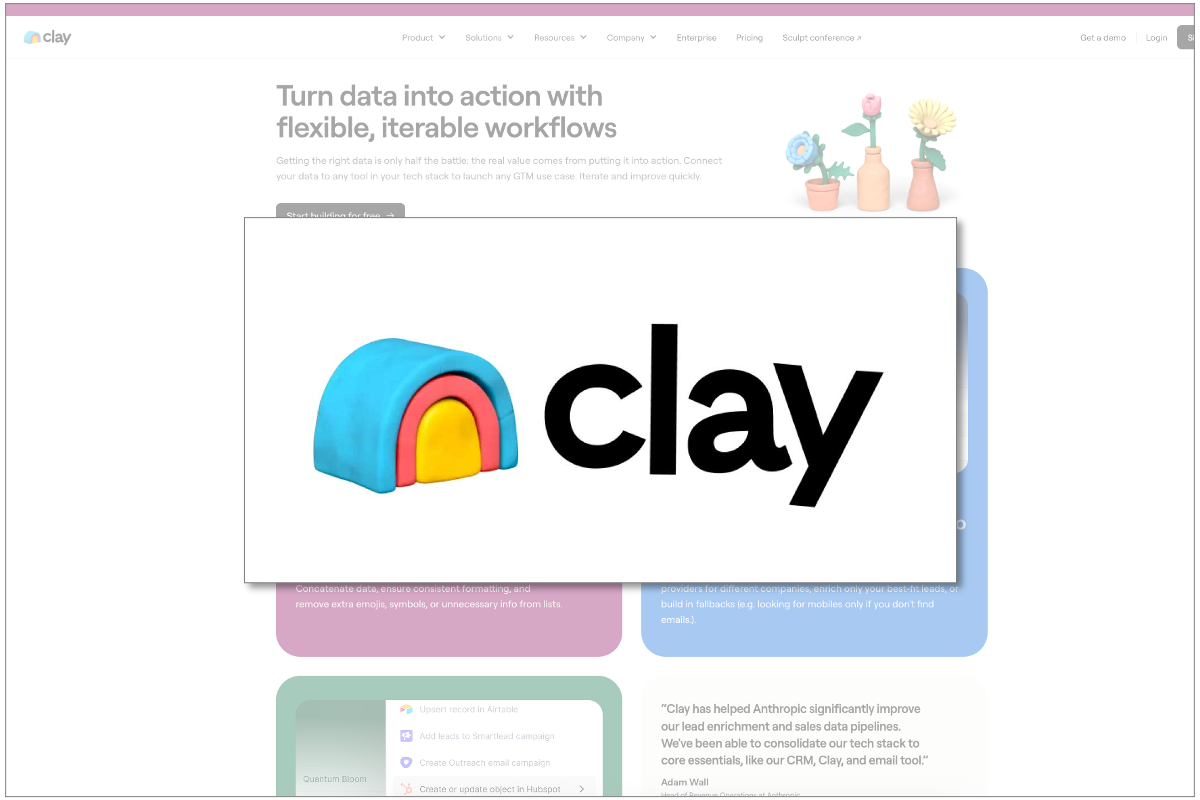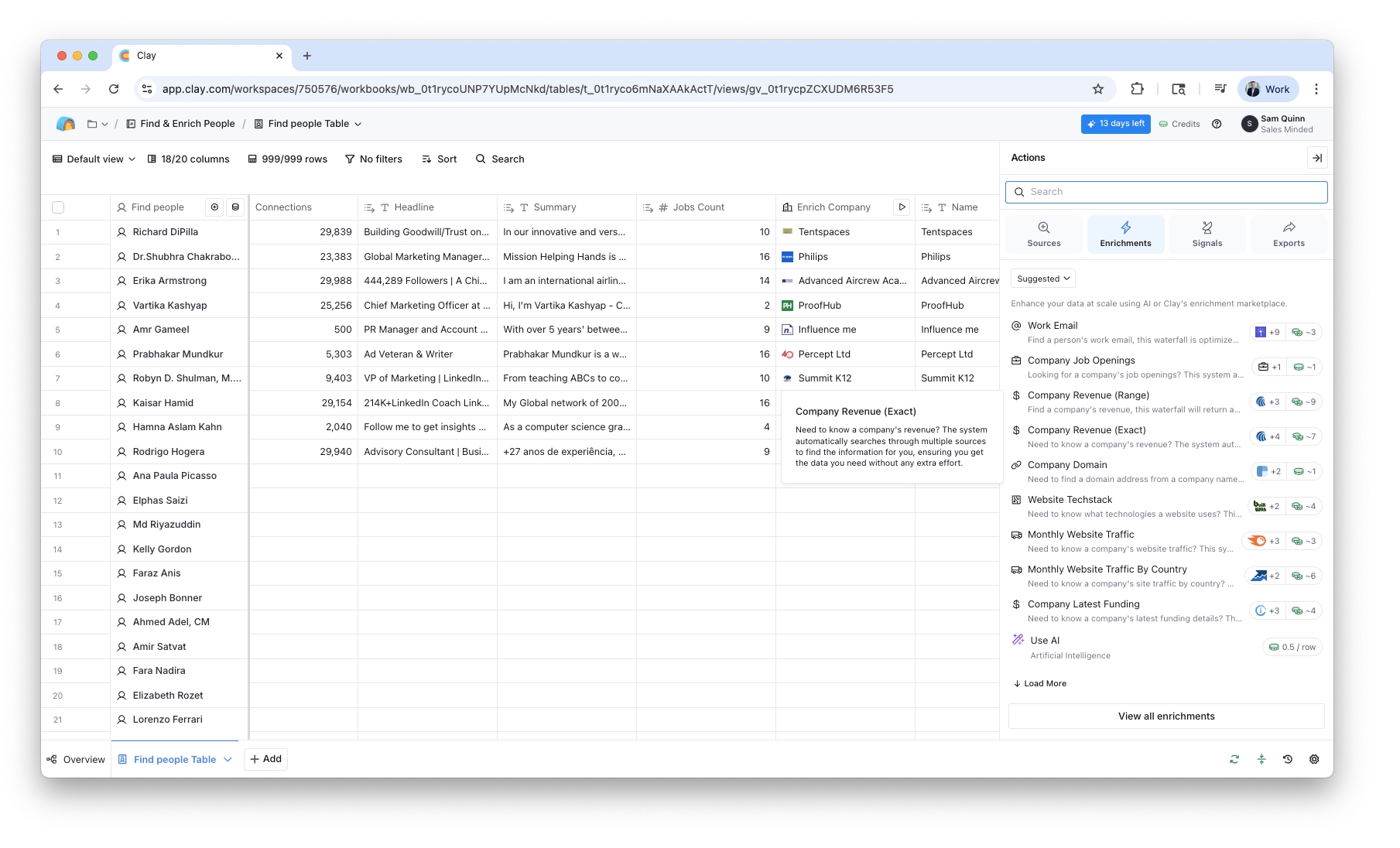


Clay combines 130+ data sources, a spreadsheet-like workflow, and its AI research agent Claygent to help sales teams build highly targeted, personalized prospecting campaigns. Instead of juggling multiple tools for list building, enrichment, research, and first-line generation, Clay automates the entire process in one platform. The result is faster, smarter, and more relevant outreach that boosts reply rates without bloating send volume.
Subscribe now and get instant access to the best AI sales tools and walkthroughs.

Clay is a modern prospecting and enrichment powerhouse that looks deceptively like a spreadsheet but operates more like a fully automated GTM data engine. At its core, it combines over 130 integrated data sources with a highly capable AI research assistant, “Claygent,” to deliver a seamless workflow for finding, enriching, and engaging prospects. You can think of it as a fusion of Google Sheets, ZoomInfo, and ChatGPT—with the difference being that it’s actually designed for revenue teams who care about personalization at scale. Clay combines data enrichment, automation, and personalization in a flexible, no-code interface. Clay is mix between a CRM, a data aggregator, and an AI-powered research assistant — all wrapped into a sleek, spreadsheet-style workflow.
Unlike legacy sales tools that silo data or require endless integrations, Clay gives salespeople control over how they source, enrich, and act on lead data. With integrations into hundreds of data providers (like Clearbit, Apollo, Hunter, LinkedIn, and more), Clay acts as a central command center where outbound efforts begin — and where repeatable, scalable prospecting happens. Clay is best known for enabling deep personalization at scale, something that outbound sellers often struggle with. Whether you’re trying to build ultra-targeted email campaigns or prioritize the best-fit accounts in your pipeline, Clay gives you the flexibility to build exactly what you need.
Clay is purpose-built for outbound professionals who measure success in reply rates, not send volume. It’s ideal for:
- SDR and BDR teams who want to break out of the “smile-and-dial” commodity game and stand out with thoughtful outreach.
- Growth marketers and demand gen pros who need to operationalize niche ICPs and trigger-based prospecting.
- Sales leaders who want repeatable, high-signal outbound motions without adding another headcount in RevOps.
- Solo founders, consultants, or boutique agencies who want to deliver enterprise-grade personalization without building a data engineering team from scratch.
If your idea of prospecting is to buy a static list, dump it into Outreach, and pray, Clay will feel like overkill. But if you value relevance, timing, and creative targeting, it’s the Swiss Army knife you didn’t know you needed.
Trigger-Based Prospecting
Identify companies who just adopted a competitor’s tool, announced funding, or posted a relevant job opening—and engage within days.
Account Deep Dives
Automate site visits, confirm compliance standards, detect new features, and summarize findings in one “intel” column for SDR prep.
Hyper-Personalized Outreach
Auto-generate first lines referencing actual, recent proof points from press releases, blogs, or investor updates.
Multi-Source Data Hygiene
Blend firmographic, technographic, contact, and intent data from multiple providers into a clean, deduped golden record.
Agency Playbooks
Build reusable flows for specific client ICPs, meter usage via credits, and bake the process into your service offering.
Enrich Lead Lists
Clay helps salespeople instantly enrich lead lists, score accounts, and generate AI-powered personalized outreach so they can scale quality conversations without sacrificing relevance.
Clay’s secret weapon is the columnar workflow—every enrichment, research step, or AI prompt is a column you can chain together, filter, and score. This turns complex GTM logic into a living, visual data pipeline.
The other big differentiator is Claygent, the AI research assistant that doesn’t just “summarize a LinkedIn profile” but actively visits websites, parses trust/compliance pages, identifies tech stack changes, detects recent announcements, and contextualizes them for outbound use. You can feed these findings directly into AI-generated first lines or full emails without leaving Clay.
Add in the ability to tap into API and HTTP columns, and you’ve essentially got a no-code RevOps platform—one that can power both bespoke ABM campaigns and high-velocity outbound lists.
PROS
- Combines over 130 native data sources, web scraping, and AI-driven research in one canvas.
- Claygent actually does research—pulling proof points, compliance data, competitive insights, and contextual triggers beyond LinkedIn headline fluff.
- Flexible credit-based pricing can be highly cost-efficient if you design smart, targeted workflows.
- Strong integration ecosystem (HubSpot, Salesforce, Gong Engage, Outreach, Salesloft) for end-to-end workflow automation.
- Eliminates the “vendor lock-in” problem by letting you pull from multiple providers at once and merge them into a single golden record.
CONS
- Credit consumption can surprise you—complex multi-column flows can chew through allotments quickly if you’re not disciplined.
- Learning curve is real; the power comes from building and linking columns like a database, which can intimidate non-technical users at first.
- Not a sequencing or sending platform—you’ll still need a separate engagement tool to execute campaigns.
- Advanced personalization requires thoughtful setup; lazy users won’t get much more than they would from a static database.
The biggest win with Clay is how it collapses what used to be four or five separate steps (and vendors) into one. In the old world, you’d grab a list from a database, enrich it with a separate tool, manually research a subset, drop it into ChatGPT for first-line generation, and then upload it into a sequencer. Clay makes that a single, automated workflow.
It also liberates teams from the tyranny of “one source of truth” by letting you cross-check and merge multiple enrichment providers, ensuring your final list is cleaner, more accurate, and richer in context than anything you’d get from a single vendor. And when you start layering on real-world triggers—funding events, tech stack installs, hiring patterns—Clay becomes an engine for relevance rather than just a list-builder.

Clay’s credit-based pricing is flexible, but it’s also a trap for the uninitiated. The first month is a high risk for “credit burn”—especially if you’re running Claygent on large datasets without testing. It rewards teams who sandbox and refine before scaling, but punishes those who treat it like a no-cost playground.
The learning curve is another factor. While the interface is clean, its spreadsheet-meets-API mindset is foreign to anyone expecting a traditional CRM-style experience. If you don’t have at least one “power user” internally, the tool’s depth can remain untapped.
And finally—Clay is not a silver bullet. If your sales culture doesn’t value research and personalization, you’ll be paying for a Ferrari and leaving it parked in the garage.
Clay uses a credit-based pricing model, where each action (data pull, AI research, API call) consumes a certain number of credits. Basic enrichments may cost 1–2 credits, while Claygent or complex API calls cost more. Plans start at around $149/month with credit allotments that scale significantly at higher tiers. Annual discounts are available.
The best way to forecast cost is to map your actual workflow—run it on a sample of 200–500 rows—then calculate the per-contact credit burn. This keeps you from overspending and lets you decide whether to optimize for volume or for ultra-high signal accounts.
Get more detailed information here >> https://www.clay.com/pricing
%20(1)%20(2).png)